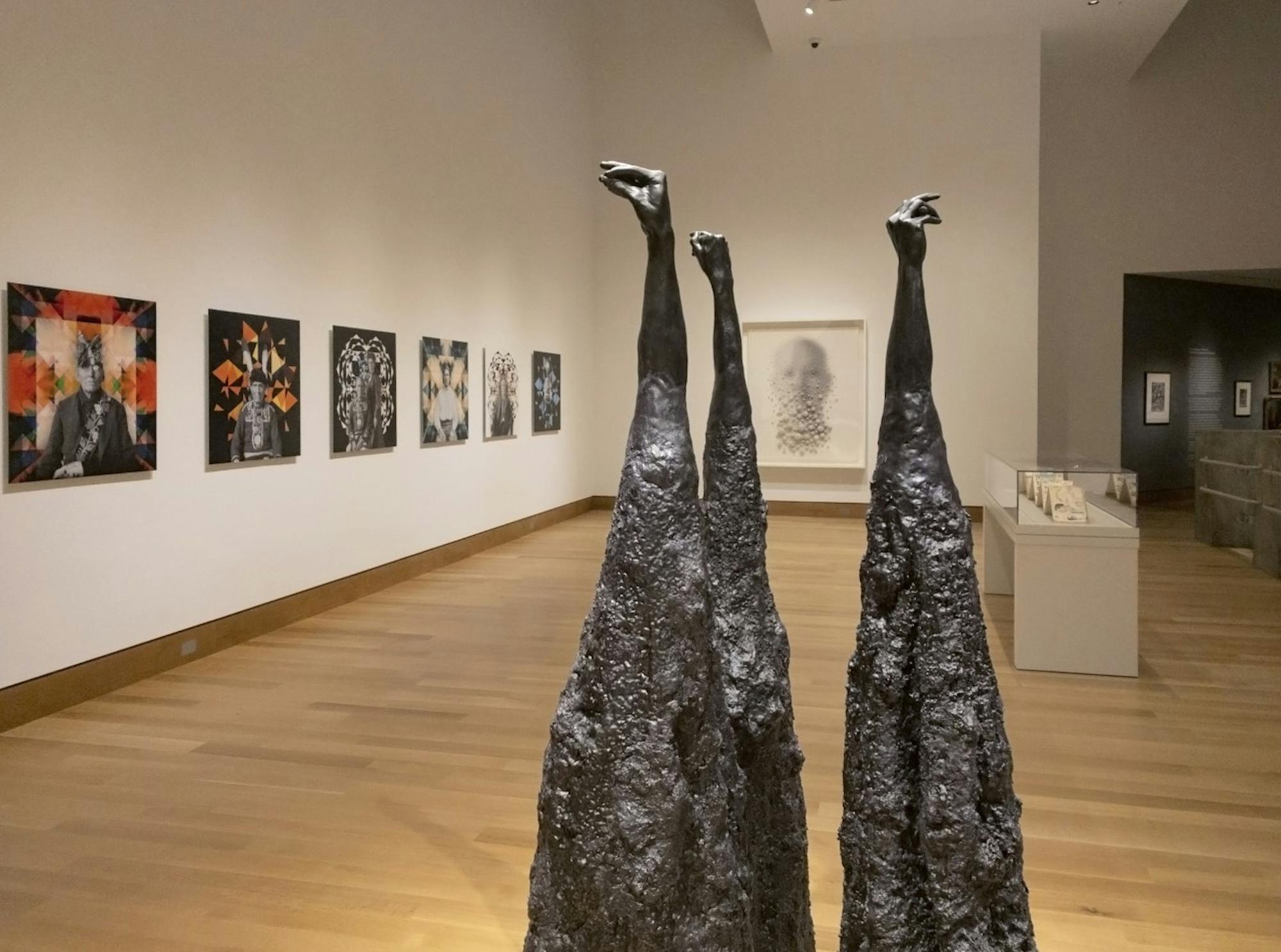The “Reconstitution” exhibit, which opened in the Hood Museum on Jan. 2 and will stay up until May 31, aims to make viewers consider how the dominant art historical narratives exclude many experiences and artists.
Curator of global contemporary art Jessica Hong curated “Reconstitution,” her second show at the Hood.
“As a contemporary curator, I wanted to show how complicated the meaning of contemporary is,” Hong said. “Because oftentimes people assume that contemporary means now and future, but the past and all of our history comes with us, it doesn’t just disappear. We have to understand the historical past to not make the same mistakes over and over again.”
Walking up the back staircase of the Hood will bring visitors to the central gallery space housing the exhibition that has works by seven artists. None of the pieces are new acquisitions for the show, but works by Terrence Koh and Gina Adams were part of a recent anonymous gift and have never been on display in the museum before.
“We’re situated in a museum context and an academic institution whose origins are rooted in colonialism, but now we’re starting to expand that story within the museological space,” Hong said.
To get viewers thinking, Hong hung four prints by 16th-century Dutch engraver Crispijn de Passe near the exhibit’s introductory blurb. Well known during his time, de Passe created a set of “Allegories of the Four Continents” that show Africa, America, Asia and Europe personified as women.
“I was really struck by the representations of each of the continents,” Hong said. “Each of them are anglicized European women, and they’re not all represented with equity. This is kind of a point of reference of how history has been told by a particular kind of Anglo-European, American and Western vantage point.”
Hong added that contemporary artists have been dealing with these very entrenched narratives, either disputing or evolving them, for a very long time.
Hong said she hopes that visitors, using the Dutch prints as a comparison, will look at the contemporary works with a critical eye.
“No one can make work in a vacuum, right?” said curator of academic programming Amelia Kahl. “You’re always responding to yourself in your experience. And if you’re an artist, you’re also thinking about other art that is happening at the same time or older art.”
Besides the prints, the other works were made between the late 1980s and 2016.
“Jessica chose rich and interesting and deep and informative work,” Kahl said. “She brought such an intellectual rigor to the show and put things together I wouldn’t have thought to.”
Kahl’s favorite piece for teaching is “Baby Back,” a 2001 printed photograph by and of Renee Cox from the “American Family Series.” The self-portrait takes the European tradition of a painted reclining female nude and riffs off it.
Kahl said she would use the photograph to prompt student discussion about the reappropriation of a European tradition and how the black female body is represented.
Kahl’s favorite piece in terms of aesthetics, however, is a Lin Tianmiao portrait that utilizes undyed cotton.
“It has this beautiful softness and this wonderful sense of touch and hand craft that I think is just so beautiful,” Kahl said. “And it’s really evocative; it feels very poetic to me.”
Much of Tianmiao’s work is about the body and its relation to power relationships, especially from the female perspective, according to Hong.
“This series consists of blown up images of heads that are kind of floating in space, and then on top of it she would then include these craft-like materials,” Hong said. Hong also noted the significance of the portrait as a medium, given its history of censorship in China.
Works from multiple collections, including Native American art, American art and European art, are present in the exhibit.
“I want to integrate the collections a bit more,” Hong said. “Although we do have geographical borders, there’s a lot of movement between them and there’s a lot of temporal blurring as well as geographical blurring, because these works are not neatly divided. There are interactions and encounters that happen whether intentionally or forced or otherwise, but they’re still interactions.”
Several Dartmouth classes, including a freshman seminar and AAAS 10, “Introduction to African-American Studies,” will visit the Hood to discuss the exhibit within the context of their courses.
According to associate curator of education Neely McNulty, local schools will also engage with the exhibit. McNulty said that she is looking forward to having conversations with regional students and community members about how these artists challenge dominant historical narratives.
“Within a small exhibition, the myriad perspectives and ways artists approach representation adds nuance and complexity to those conversations,” McNulty said. “Many of the works inspire more questions than they answer, and that’s a good thing.”
Hong said she hopes to encourage conversations about the Western narratives that are usually privileged in museums.
“My curatorial practice has always been wanting to lean into this idea of nuance, as opposed to me giving you answers of how you should interpret the work,” Hong said. “It may be uncomfortable, but that discomfort allows for us to engage in difficult dialogues.”
Correction appended (Jan. 27, 2020): This article originally contained a quote attributed to Jessica Hong as a part of the discussion of the print "Baby Back." However, she was referring to another work in the exhibit. This quote has been removed.


